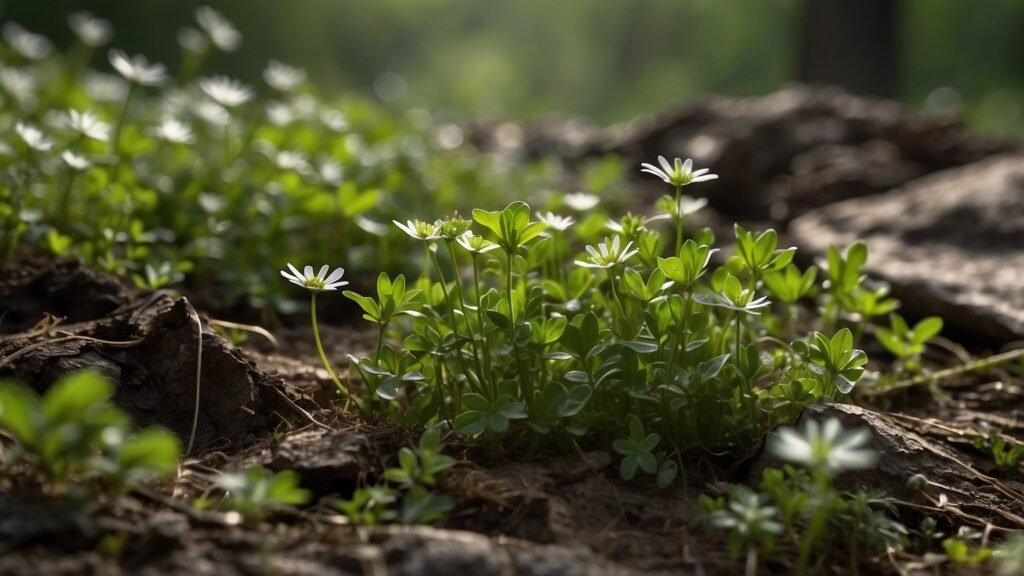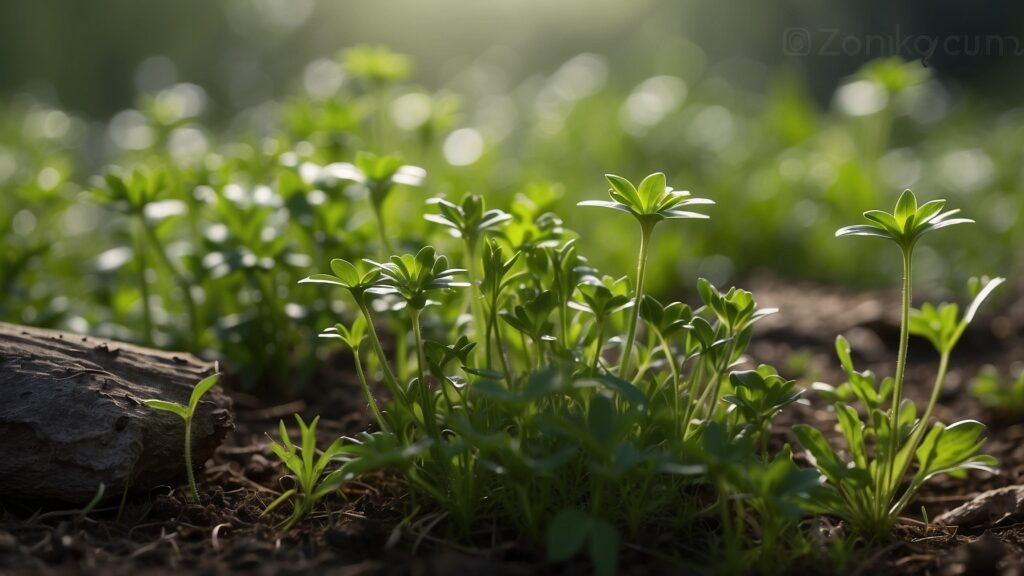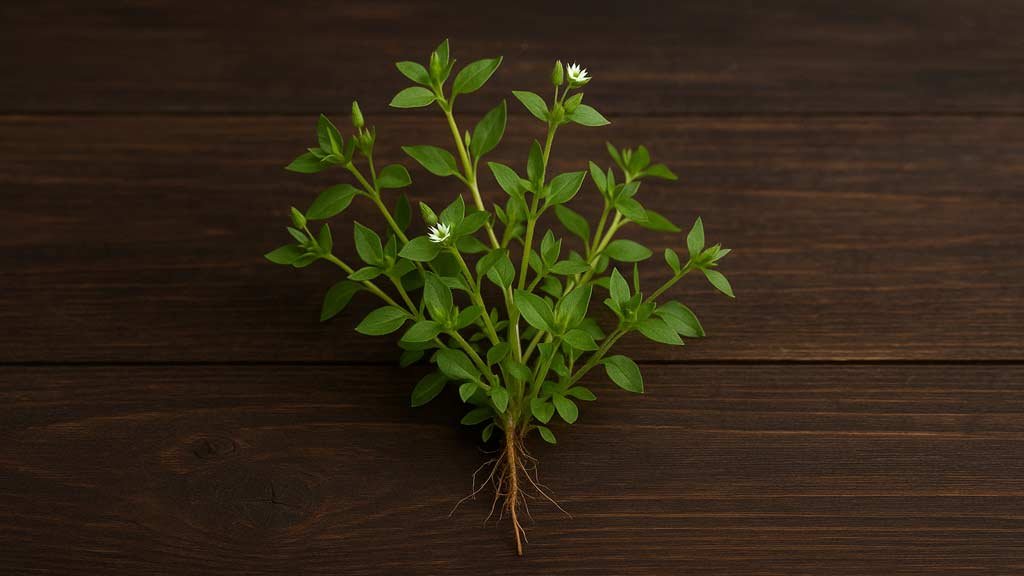A First Encounter with Chickweed
If you’ve ever wandered through a damp meadow or an untended garden, chances are you’ve met chickweed without even noticing. Stellaria media, that delicate, sprawling little green with star-like white flowers, has a way of carpeting the ground quietly. Most people dismiss it as a weed, but here’s the thing—it’s more than just a wild green choking up your garden rows. Chickweed has been used in traditional herbal practices for centuries, prized for its cooling, soothing qualities. Its presence in folk medicine is nearly universal, from Europe to Asia and even across North America.
When I first learned about chickweed, it wasn’t from a textbook or a fancy herbal compendium—it was from an older neighbor who swore by her chickweed salve. She claimed it could calm rashes faster than anything you’d buy at a pharmacy. I was skeptical, of course, but after trying it on a mild sunburn, I saw why she trusted it. The relief was instant, like dipping hot skin into cool water. That’s chickweed’s gift: gentle, unassuming, but effective.
Table of Contents
Nutritional Profile of Chickweed
Before getting into its therapeutic side, it helps to understand why chickweed is valued as both food and medicine. Chickweed is surprisingly nutrient-dense, which might explain why traditional healers saw it as strengthening to the whole body.
Chickweed is known to contain:
- Vitamins: A, B-complex, C, and E
- Minerals: Iron, calcium, magnesium, potassium, zinc, and selenium
- Phytochemicals: Saponins, flavonoids, and coumarins
That combination alone makes it more than “just a weed.” The fresh plant is often eaten raw in salads, where its flavor is mild, almost like young spinach with a touch of corn silk sweetness. Herbalists often say that plants thriving abundantly around us tend to be exactly what our bodies need—chickweed is a perfect example.
Chickweed and Skin Health
Cooling Relief for Irritations
One of chickweed’s best-known benefits is its ability to cool and calm inflamed skin. Traditional herbal medicine often turned to chickweed poultices or salves for:
- Eczema flare-ups
- Psoriasis patches
- Heat rashes
- Insect bites and stings
- Minor burns and sunburn
When applied externally, chickweed acts almost like a breathable shield. The saponins in the plant may enhance the penetration of active compounds, helping the skin absorb its soothing agents. Some people describe the feeling as “a green coolness that stays,” unlike the fleeting chill of aloe vera.
The Softening Effect
Chickweed doesn’t just reduce redness—it helps soften rough or dry skin. The herb has emollient properties, meaning it traps moisture and leaves the skin feeling more supple. I’ve noticed this when using chickweed ointments during cold winters, when hands crack from dry air. It’s not greasy or heavy like some oils; it’s light, gentle, and feels natural.
Traditional Topical Applications
Folk healers often crushed fresh chickweed leaves and applied them directly to affected areas. In more modern preparations, chickweed is infused into oils and blended into creams or balms. Herbalists sometimes mix it with calendula or plantain for an even more powerful skin remedy.

Chickweed and Digestion
Gentle Aid for the Gut
If you’ve ever felt bogged down by heavy meals or sluggish digestion, chickweed can be a quiet ally. Its traditional role as a digestive tonic comes from its mild laxative effect. Thanks to its saponins and fiber, chickweed supports smoother elimination without the harsh grip of stronger herbal laxatives.
People have used chickweed tea to ease:
- Occasional constipation
- Indigestion from fatty foods
- A feeling of heaviness in the stomach
It’s not a drastic purge—it’s more like a gentle nudge to the digestive system.
Liver and Metabolic Support
Herbal traditions also connect chickweed with liver health. Because of its mild detoxifying properties, chickweed tea or tincture was often recommended for people struggling with sluggish metabolism or skin breakouts linked to poor liver function. Some herbalists suggest that chickweed helps the body process fats more efficiently, which may be why it appears in old remedies for “stoutness” or “flesh-reducing” teas.
The Taste and Experience
Drinking chickweed tea is a sensory experience. It has a light, grassy flavor with a slightly sweet finish, much less bitter than many other medicinal herbs. It feels cleansing without being punishing, and it’s easy to drink daily without forcing it down.
Chickweed as a Nourishing Food
Foraging and Eating Chickweed
Beyond its role as medicine, chickweed is simply a nutritious wild food. Foragers often harvest it in early spring when it’s most tender. You can toss it into salads, soups, or even pesto. I once made a chickweed omelet, and the greens gave it a freshness that spinach couldn’t match—delicate, bright, and alive.
Everyday Benefits of Eating Chickweed
Eating chickweed regularly may provide:
- A natural source of vitamins during spring foraging season
- Minerals that support bone and joint health
- A boost of chlorophyll, known for its cleansing qualities
Unlike many wild edibles that are bitter or fibrous, chickweed is palatable and easy to enjoy. It’s the kind of plant that bridges the gap between food and medicine seamlessly.

Traditional and Historical Uses
Herbal traditions rarely survive for centuries unless a plant truly works. Chickweed has been recorded in European herbals since at least the Middle Ages. In Traditional Chinese Medicine, it’s considered cooling and moistening, used to clear heat and relieve inflammation. Native American herbalists also valued chickweed as a poultice for wounds and as a tea for respiratory and digestive complaints.
These widespread uses suggest that chickweed’s qualities are universally recognizable—soothing, cooling, balancing. It’s the herb you turn to when the body feels overheated, inflamed, or clogged.
Chickweed in Modern Herbalism
Extracts, Teas, and Tinctures
Today, herbalists still rely on chickweed in many forms:
- Fresh plant tinctures capture its vitality best.
- Dried tea provides a gentle daily tonic.
- Infused oils and salves remain staples for skin issues.
Unlike some herbs that lose potency when dried, chickweed retains much of its effectiveness, though many practitioners insist the fresh plant carries the most life force.
Synergy with Other Herbs
Chickweed rarely stands alone in modern formulas. It’s often combined with:
- Nettle for nutrient density
- Cleavers for lymphatic support
- Calendula for skin healing
- Dandelion for liver health
These pairings make sense when you think about how chickweed works—gentle, supportive, enhancing rather than overwhelming.
Safety and Precautions
Chickweed is considered very safe for most people, especially when used as food. However, like any herb, there are a few considerations:
- Those allergic to plants in the Caryophyllaceae family should use caution.
- Large amounts of chickweed tincture may cause mild stomach upset.
- Pregnant or breastfeeding individuals should consult a knowledgeable practitioner before regular use.
Overall, it’s one of the least concerning herbs in terms of side effects. Its very gentleness makes it a plant you can integrate into daily life without much worry.
The Subtle Power of Chickweed
What strikes me most about chickweed is how unassuming it is. This isn’t a flashy herb that screams for attention with bold flavors or intense effects. It works quietly, cooling irritation, easing digestion, nourishing the body. In a world obsessed with quick fixes and powerful remedies, chickweed offers a reminder that healing doesn’t always need to be loud.
Maybe that’s why so many herbalists hold it dear. Chickweed is the plant that sits in the background, asking for nothing, while giving plenty. It’s the green patch you might pull up as a nuisance, not realizing you’re holding medicine in your hands.
Article Sources
At AncientHerbsWisdom, our content relies on reputable sources, including peer-reviewed studies, to substantiate the information presented in our articles. Our primary objective is to ensure our content is thoroughly fact-checked, maintaining a commitment to accuracy, reliability, and trustworthiness.
- Brinkhaus, B., Schindler, G., Lindner, M., & Stöckigt, J. (2000). Chemical and pharmacological investigations of Stellaria media (chickweed). Phytomedicine, 7(5), 395–401. https://doi.org/10.1016/S0944-7113(00)80061-5
- Chevallier, A. (2016). Encyclopedia of herbal medicine (3rd ed.). DK Publishing.
- Grieve, M. (1971). A modern herbal: The medicinal, culinary, cosmetic and economic properties, cultivation and folklore of herbs, grasses, fungi, shrubs and trees with all their modern scientific uses. Dover Publications.
- Hoffmann, D. (2003). Medical herbalism: The science and practice of herbal medicine. Healing Arts Press.
- Mount Sinai. (2020). Chickweed. Mount Sinai Health Library. Retrieved from https://www.mountsinai.org/health-library/herb/chickweed
- Natural Medicines. (2022). Chickweed (Stellaria media) monograph. Natural Medicines Comprehensive Database. Retrieved from https://naturalmedicines.therapeuticresearch.com
- Peterson, L. A. (2021). Peterson field guide to medicinal plants and herbs of eastern and central North America (3rd ed.). Houghton Mifflin Harcourt.
- WebMD. (2023). Chickweed overview. WebMD. Retrieved from https://www.webmd.com/vitamins/ai/ingredientmono-391/chickweed

